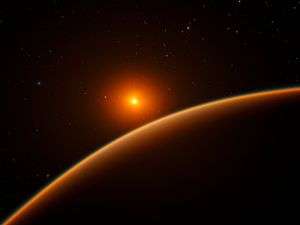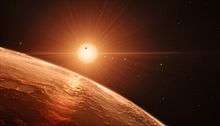LHS 1140
 Artist's impression of LHS 1140 and LHS 1140b. | |
| Observation data Epoch J2000.0 Equinox J2000.0 | |
|---|---|
| Constellation | Cetus |
| Right ascension | 00h 44m 59.31s[1] |
| Declination | −15° 16′ 16.7″[1] |
| Apparent magnitude (V) | 14.18[2] |
| Characteristics | |
| Evolutionary stage | Red dwarf |
| Spectral type | M4.5V[2] |
| Astrometry | |
| Radial velocity (Rv) | -13.23 ± 0.60[2] km/s |
| Proper motion (μ) | RA: 317[3] mas/yr Dec.: -589[3] mas/yr |
| Distance | 40.67 ± 1.37 ly (12.47 ± 0.42[2] pc) |
| Details[2] | |
| Mass | 0.146 ± 0.009 M☉ |
| Radius | 0.186 ± 0.013 R☉ |
| Luminosity | 0.002981 ± 0.00021 L☉ |
| Temperature | 3131 ± 100 K |
| Metallicity [Fe/H] | -0.24 ± 0.10 dex |
| Rotation | 131 d |
| Age | >5 Gyr |
| Other designations | |
| Database references | |
| SIMBAD | data |
| ARICNS | data |
LHS 1140 is a red dwarf in the constellation of Cetus. Based on its stellar properties, it is thought to be about 41 light-years away from the Sun.[2] 'LHS' refers to the Luyten Half-Second Catalogue of stars with proper motions exceeding half a second of arc annually.[4] The star is over 5 billion years old and has 15% of the mass of the Sun. LHS 1140's rotational period is 130 days. No flares have been observed.[5]
LHS 1140 has a rocky planet, LHS 1140 b, orbiting it. The planet is a super-Earth in a habitable zone and transits the star. This should allow its atmosphere to be studied in future: the combination of the transiting super-Earth and the relatively small and nearby host star make this system one of the most promising known for atmosphere studies, along with the TRAPPIST-1 system.[2][6] The mass of LHS 1140b is about 7 times Earth's, and its radius about 1.7 times as large, giving it a density of about 7.5 g/cm3,[7] compared to Earth's 5.5 g/cm3.
In July 2018, Feng et al. published a reanalysis of the radial velocity data for LHS 1140 and proposed the likely existence of two additional planets: an inner Earth-mass planet orbiting every 3.8 days and an outer Neptune-mass planet orbiting every 90 days.[8] In August 2018, Ment et al., using the transit method of detection, confirmed the existence of the inner planet LHS 1140 c with a mass about 1.8 times Earth's and a radius, 1.3 times as large, giving it a density of about 5 g/cm3.[7]
| Companion (in order from star) |
Mass | Semimajor axis (AU) |
Orbital period (days) |
Eccentricity | Inclination | Radius |
|---|---|---|---|---|---|---|
| c | 1.81 ± 0.39 M⊕ | 0.02675 ± 0.00070 | 3.777931 ± 0.000003 | < 0.31 | 89.92° | 1.282 ± 0.024 R⊕ |
| b | 6.98 ± 0.89 M⊕ | 0.0936 ± 0.0024 | 24.73712 ± 0.00025 | < 0.06 | 89.912 ± 0.071° | 1.727 ± 0.032 R⊕ |
| d (candidate) | 9.64-11.11 M⊕ | 0.210 | 92-93 | 0-0.03 | ~90° | — |
The orbit of LHS 1140b is nearly circular with a radius of 0.09 AU. LHS 1140b orbits and transits the star every 24.7 days.[2] The planet was discovered in 2017 by the MEarth Project. Radial velocities were measured by High Accuracy Radial Velocity Planet Searcher.[5]
See also
References
- 1 2 Cutri, R. M.; et al. (2003). "2MASS All-Sky Catalog of Point Sources". VizieR On-line Data Catalog. 2246. Bibcode:2003yCat.2246....0C.
- 1 2 3 4 5 6 7 8 9 Dittmann, Jason A.; Irwin, Jonathan M.; Charbonneau, David; Bonfils, Xavier; Astudillo-Defru, Nicola; Haywood, Raphaëlle D.; Berta-Thompson, Zachory K.; Newton, Elisabeth R.; Rodriguez, Joseph E.; Winters, Jennifer G.; Tan, Thiam-Guan; Almenara, Jose-Manuel; Bouchy, François; Delfosse, Xavier; Forveille, Thierry; Lovis, Christophe; Murgas, Felipe; Pepe, Francesco; Santos, Nuno C.; Udry, Stephane; Wünsche, Anaël; Esquerdo, Gilbert A.; Latham, David W.; Dressing, Courtney D. (2017). "A temperate rocky super-Earth transiting a nearby cool star". Nature. 544 (7650): 333. arXiv:1704.05556. Bibcode:2017Natur.544..333D. doi:10.1038/nature22055. PMID 28426003.
- 1 2 Salim, Samir; Gould, Andrew (2003). "Improved Astrometry and Photometry for the Luyten Catalog. II. Faint Stars and the Revised Catalog". The Astrophysical Journal. 582 (2): 1011. arXiv:astro-ph/0206318. Bibcode:2003ApJ...582.1011S. doi:10.1086/344822.
- ↑ Luyten, Willem Jacob, Catalogue of stars with proper motions exceeding 0"5 annually, University of Minnesota, 1979
- 1 2 Dickinson, David (19 April 2017). "Welcome to LHS 1140b: A Super-Earth in the Habitable Zone". Sky & Telescope. Retrieved 19 April 2017.
- ↑ Overbye, Dennis (19 April 2017). "A New Exoplanet May Be Most Promising Yet in Search for Life". New York Times. Retrieved 20 April 2017.
- 1 2 3 "A second planet with an Earth-like composition orbiting the nearby M dwarf LHS 1140". Kristo Ment, Jason A. Dittmann, Nicola Astudillo-Defru, David Charbonneau, Jonathan Irwin, Xavier Bonfils, Felipe Murgas, Jose-Manuel Almenara, Thierry Forveille, Eric Agol, Sarah Ballard, Zachory K. Berta-Thompson, Franc¸ois Bouchy, Ryan Cloutier, Xavier Delfosse, Rene Doyon, Courtney D. Dressing, Gilbert A. Esquerdo, Raphaelle D. Haywood, David M. Kipping, David W. Latham, Christophe Lovis, Elisabeth R. Newton, Francesco Pepe, Joseph E. Rodriguez, Nuno C. Santos, Thiam-Guan Tan, Stephane Udry, Jennifer G. Winters, and Anael W unsche (August 3, 2018).
- 1 2 https://arxiv.org/pdf/1807.02483.pdf

